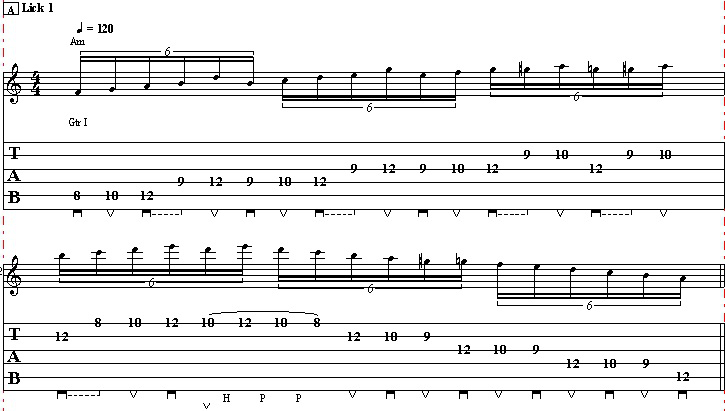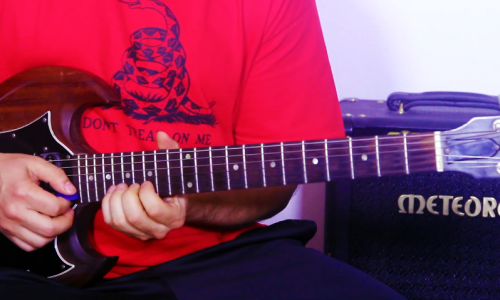Hey, how’s it going this is Darrin Goodman with Guitar Control, I want to show you how to play “Hellion” by Judas Priest. This is like the little Intro section to the song electric eye on screaming for vengeance anyway this is a cool song to play with a friend because it’s got a harmony so kind of want to show it to you is a just another cool riff that you can play.
Click on the Tabs button to follow chords and tabs.
On the recording it has three guitar parts they’re being played but on live they do just only two so we’re going to be looking at this as a live version so you can go and play it with a friend. Let’s start with what guitar two is doing first guitar two in the beginning of it is just playing chords and the rhythm part and it’s really easy to play so the first thing we have is just an E5 power chord so I’m on the 9th fret of the 5th string with my first finger and the 7th fret of the 5th string with our first finger and then the 9th fret of the 4th and 3rd string with our third finger that is the shape that we’re going to be playing throughout this we’re just going to be moving it around so we start off with E5 and it’s a whole note so it’s just going to ring out 4, 4, 4, and the next major we just move it down a whole step to D5. So now I’m on the 5th string on the 5th fret with my first finger and the 7th fret of the 4th and 3rd strings with my third finger this is also a whole note then the next major goes to a C5, so we move it down another entire whole step so now I’m on the 3rd fret 5th string with my first finger and the 5th fret of the 4th and 3rd string with my third finger and this is a plate as a dotted quarter note so what that means if you don’t know what it would what a dotted note is it’s simply that you know it’s a quarter note which gets one beat and so it’s dotted anytime a notice dotted you is take 50% of its value and add it to it so in other words this chord is going to ring out for one and a half beats it’s going to ring out for the entire quarter note of beat number one and then it’s going to ring out on half of beat number two and then on the end of two we’re going to switch back to the D5 and it is a half note this tied to an 8th note so that’s going to account for the rest of the measure so measure number four you got and then it just simply starts over because it repeats.
On the record like I said that part that holding those chords continues throughout the whole thing so it would be a total of 16 measures of doing but like I said you know unless you got two buddies who play guitar and all three of you can play this but live it’s just the bass player that’s hitting those notes.
So guitar two this already gets into that little melody that starts off we’re on the 9th fret of the 4th string whether a third finger and this is also actually starting on the end of one, so when you’re just playing this by yourself it sounds kind of strange because what’s driving is that comes on first so it’s like a rock fret you’re getting that E note to kind of drive it to start off with when you’re displaying this alone it is going to sound a little bit strange but you just want to make sure that you don’t hit this note on the downbeat of one because you’ll be ahead and it will not sound right, so 9th fret of the 4th string with your third finger and then from there it goes to the 8th fret of the 2nd string second finger and then to the 7th fret of the 2nd string with my first finger with some vibrato and then to the 9th fret of the 3rd string with my third finger that’s the first measure source then the second measure is the exact same thing because remember the chords 1, 2, 3, 4, and again 1, 2, 3, 4, so we got, and then on the third measure when the other guitar switches to them in the D5 we start off with that same 9th fret of the 4th string, but now we’re going to use our first finger to play that note and then from there it’s going to go to the same rhythm and timing as the other measures but it’s just those two notes change so instead of being 8, 7 now we’re going to go 12 and 10 to 12 on the 3rd string. So 9th fret of the 4th string with your first finger to the 12th fret of the 2nd string and I’m using my fourth finger to the 10th fret with my second finger and then to the 12th fret of the 3rd string, now you could use your first three fingers if you want you know whatever is more comfortable which one you get up this high frets closer together and just you know depending upon the size of your hands, you know what’s more comfortable and I honestly probably don’t play it the same way every time you know just kind of my hands kind of on autopilot and I just do whatever.
So the first three measures and then for the fourth measure you’re going to want to reach up in barre across the 10th fret of the 5th and 4th string with your second finger to the 12th fret of the 4th string with your fourth finger and then your first finger barre across the 9th fret of the 3rd and 4th strings. So that last measure and then it just starts over again because it’s a repeat so guitar one that is playing this little melody you go through it’s four measures long and then you repeat it, so now you played eight measures and then on the next section where the harmony comes in you continue to play that and it’s also repeat so another measure so it’s it ends up being a total of 16 measures long so that that whole section slowly.
Now for the harmony part of it, this is where guitar two was playing and going to join in and do a harmony with this so the first three measures the timing is exactly the same as what guitar one is doing it’s just it’s different notes too to make the harmony the fourth measure is a little bit different and we’ll talk about that when we get there. For this section we’re going to start off on the same note period but we’re going to be using our first finger then to the 12th fret of the 2nd string with your fourth finger to the 10th fret and then to the 8th fret and I use my first finger the first and second measure of this section are both are not the same just like for guitar one and then for the third measure of this we’re going to go up to the 14th fret on the 4th string and I’m going to use my third finger and I’m going to go to the 12th fret of the 3rd string with my second finger and then all the way up to the 16th fret with my fourth finger, so this one’s a little more of an awkward change but like I said it’s the harmony to that other part.
So let’s play those first three measures of the harmony and then from there the very last measure which isn’t a harmony with what’s going on it just kind of goes you know it’s kind of strange source if you just play it by itself it sounds a little weird but when they’re play together it actually sounds really cool it is just simply the 12th fret of the 1st string I’m using my third finger and this is a dotted quarter note so this is going to account for beat number one and then the first half of beat number two then to the 10th fret of the 1st string I use my first finger and this is also a dotted quarter note so these two notes actually take up the first three beats so it would be like 1 and 2 and 3 and then back to 12, 4, 4, and then just starts over.
I hope you enjoyed that and got something out of it. If you’ve got a friend you can play it together or if you have a loop or you can use a looper or you even grab your cell phone and record yourself playing that melody so in that way you can play the harmony along with it or you could do it the other way around you know whichever way you want to do in fact it’s probably a good idea to do both. It’s a good practice so if you enjoyed that be sure to subscribe to on our You Tube Channel and we’ll see you in our next video lessons, thanks for watching.
[ninja-popup ID=715]




